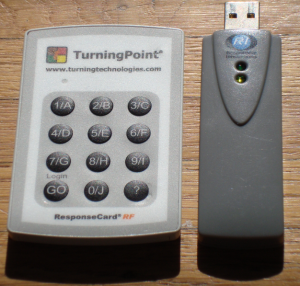Check our special offers on ResponseCards
This review covers the ResponseCard RF (RCRF-01). The ResponseCard RF measures a tiny 3.3″ L x 2.1″ W x 0.3″ H and weighs approximately 1 oz. with it’s batteries installed. It is roughly the size of a credit card. The ResponseCard RF can only be used with TurningPoint, the audience response system written by Turning Technologies.

Ease of use – 5 of 5
ResponseCards cards are very easy to use once they are correctly setup and on the proper channel. Simply press the button that matches the answer choice on screen, 1/A through 0/J. When using the ResponseCard RF you will see different sequences of blinking lights.
- Green: Your response has been received.
- Amber/orange/yellow (single flash): Polling is not open. You are not able to vote yet.
- Amber/orange/yellow (multiple flashes):Your response is being transmitted.
- Red: Your response was not accepted. Make sure that your keypad is set to the correct channel.
- Alternating red and green:You have pressed the GO or Ch button. You have begun the channel changing process. If you pressed the button accidentally, just wait a couple seconds. The process will timeout shortly.
For more details on the ResponseCard RF, consult our article on how to use the ResponseCard
Range – 5 of 5
The range of the ResponseCard RF, when used with the standard receiver, is rated at a straight line distance of 200 feet. My tests show this number to be very conservative. I performed an outdoor test on 07/12/10. The temperature was 69°F, humidity was 44% and winds were light and variable. With a clear line of sight and no obstructions, I recorded a maximum straight line range of 564 feet. I wouldn’t recommend having the ResponseCard receiver placed more than 300 feet from the most distant responder, though. At 300 feet, responses took up to 3 seconds to be acknowledged by the receiver.
Aesthetics – 4.5 of 5
I love that the ResponseCards are credit card sized and weigh about an ounce. The most recent revision has a loop to attach a lanyard directly to the keypad, rather that having to slip the keypad into a plastic sleeve and attach the lanyard to the sleeve. The design is clean, simple and high visibility. If dropped on the floor of a dimly lit ballroom, you won’t have any problem spotting it.
Scalability – 5 of 5
I’ve given these keypads a perfect 5 in scalability for 2 reasons. First, you can use up to 1000 ResponseCards per USB receiver. The number of keypads you can use is limited only by how many USB devices you can plug into your computer. The second reason has nothing to do with the ResponseCard but rather it’s companion software, TurningPoint and ResponseCard AnyWhere. They allow you to combine votes cast at multiple locations in real-time as if the entire audience was located in the same room.
Durability – 5 of 5
These clickers are nearly indestructible. In addition to the normal abuse that I have subjected ResponseCards to by using them at meetings all over the world, additional tests have seen them dropped out of a 5th story window onto a parking lot, run over by a Jeep, left in a freezer for a week and dunked in water.
Portability – 4.5 of 5
The size and weight of a ResponseCard makes transporting large numbers of them to and from a venue a breeze. Coming in at roughly the size of a credit card, ResponseCards may be a little too portable for their own good, as they seem to have a way leaving the meeting room in the pockets of attendees. For this reason, I’ve deducted .5 of a point from this category.
Conclusions
The ResponseCard RF is a robust ARS keypad that can stand up to the punishment of even the most demanding meetings. Their minimalistic design makes it simple for first-time users to figure out how to submit a vote and the ability to use multiple receivers allows you to cover even the largest room. When using ResponseCards, run a test prior to your meeting, to ensure that all clickers are on the correct channel and responses are being received by TurningPoint. I would highly recommend using a ResponseCard RF system at events ranging in size from a 10-person advisory board up to to an association meeting with thousands of attendees.

Thanks for the insight… good Blog. I bookmarked this and will check back again. 🙂